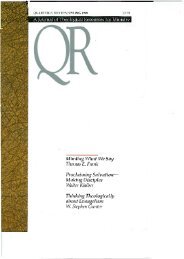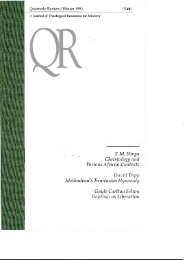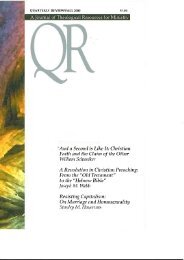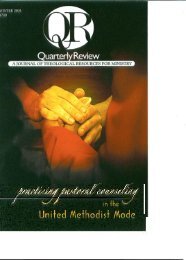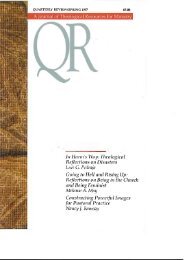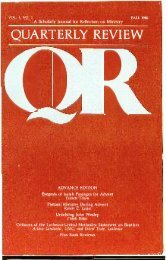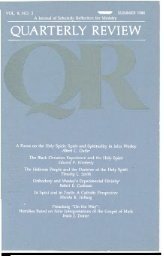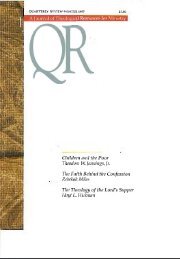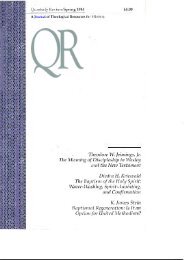Winter 1984 - 1985 - Quarterly Review
Winter 1984 - 1985 - Quarterly Review
Winter 1984 - 1985 - Quarterly Review
Create successful ePaper yourself
Turn your PDF publications into a flip-book with our unique Google optimized e-Paper software.
QUARTERLY REVIEW, WINTER <strong>1984</strong><br />
man, what is good, and what does the Lord require of you but to do<br />
justice and to love kindness and to be humble in going with your God?" 9<br />
After God had created man and woman in God's image as the<br />
governors of all creatures, God attached the phrase "very good" to the<br />
finished work. In this verse of Micah, good is doing justice, loving<br />
kindness, and being humble in going with God. In a human community<br />
where these requirements are fulfilled, God's image becomes visible.<br />
That is what God tells humanity through the Word of God. When we<br />
look at Jewish tradition this is in a nutshell what the Torah spells out in<br />
great detail. The purpose of the Torah is to create such a community,<br />
and its final goal is that the whole of humanity will live according to<br />
these requirements of God, which in the Micah verse are addressed to<br />
"Adam," humanity. Then it will be visible that "Adam," the whole of<br />
humanity, has been created in the image of God.<br />
Jesus was "Torah in the flesh/' a man who embodied<br />
Torah, all of whose actions were Torah.<br />
As a Christian I confess "the Word became flesh" (John 1:14). I<br />
believe that in this confession the "Word" should be understood in<br />
the sense of "Torah" and that thus "the Word became flesh" should<br />
be understood as: "the Torah took on flesh and blood." This means:<br />
Jesus was so to speak, "Torah in the flesh," a man who embodied<br />
Torah, all of whose actions were Torah. In him became transparent<br />
the purpose of the Torah to bring about a kind of human existence in<br />
which the image of God is visible.<br />
All this is confirmed and strengthened as we look at the picture<br />
drawn of Jesus in the Synoptic Gospels. When we disregard for a<br />
moment such polemical passages as those regarding the scribes and<br />
Pharisees which reflect the tensions between the early Christian<br />
community and the Pharisee movement about forty years after Jesus'<br />
death, and look at what Jesus actually said and did, then a genuinely<br />
Jewish picture emerges. The Sermon on the Mount strongly<br />
resembles rabbinic teachings, and Jesus' parables and sayings find<br />
remarkable parallels in rabbinic literature. He lived a Jewish life,<br />
marked by the sign of the covenant, the circumcision, from the eighth<br />
day of his life. He went to the synagogue and prayed Jewish prayers<br />
that even today are prayed in the synagogues all over the world. His<br />
life and behavior were articulated by the commandments given to<br />
58



